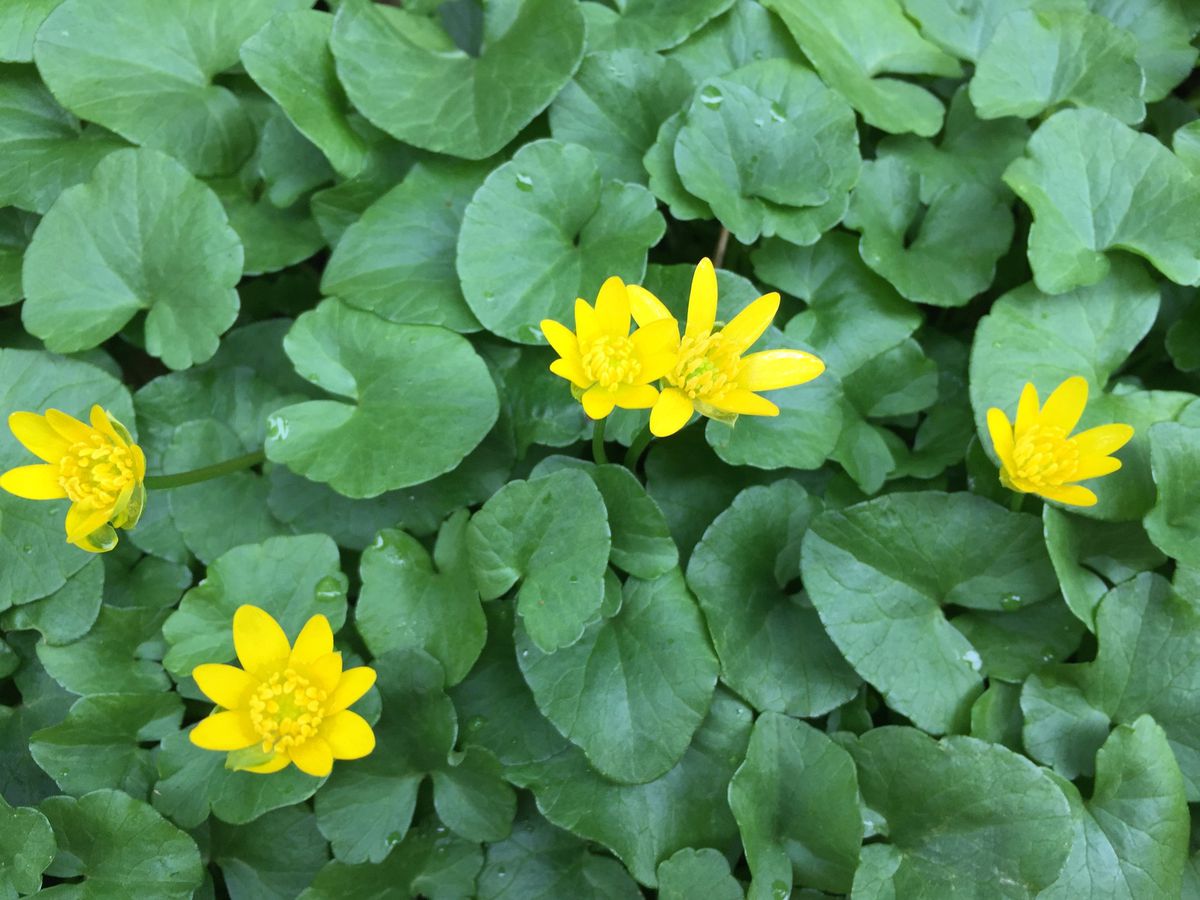Gardeners love groundcovers for their ability to quickly fill in bare areas with lush greenery. But sometimes unwanted weedy groundcovers can creep into garden beds or lawns, displaying bright yellow flowers as they spread. These low-growing weeds can quickly take over space meant for other plants. Knowing how to identify the most common yellow-flowered groundcover weeds will help you control them.
Creeping Buttercup
One of the most prevalent groundcover weeds displaying yellow flowers is creeping buttercup (Ranunculus repens). In lawns, sunny borders, and moist areas, small butter-yellow flowers on creeping stems signal an invasion of creeping buttercup.
This perennial weed sinks fibrous roots as it forms mats from 3 to 12 inches high, The leaves are divided into three lobes Creeping buttercup spreads aggressively by above and below-ground runners
Hand pulling can control small patches. For larger areas, apply a broadleaf herbicide. Maintaining a thick, healthy lawn helps minimize creeping buttercup.
Creeping Cinquefoil
With its bright yellow flowers and spreading habit, creeping cinquefoil (Potentilla reptans) quickly becomes a nuisance in neglected lawns. The leaves feature five toothed leaflets resembling a cinquefoil.
Creeping cinquefoil forms dense mats as its stems root at intervals. It thrives in poor, compacted soil and depleted lawns. Vigorous vertical shoots give creeping cinquefoil an unkempt look.
Manual removal provides temporary control. For heavy infestations, use a selective herbicide followed by improvement of soil and growing conditions. Fertilizing and aerating helps grass outcompete creeping cinquefoil.
Lesser Celandine
Lesser celandine (Ficaria verna) emerges early in spring, forming mats of dark green, heart-shaped leaves. Bright yellow cup-shaped flowers cover the ground from March to May.
Native to Europe, this perennial groundcover weed has become invasive in North America. It spreads vigorously through tubers and rapid seeding. Lesser celandine thrives in moist woodlands and blooms before tree canopy blocks light.
Eliminate small patches by digging up entire plants. Severe infestations may need herbicide applications before flowering. Prevent spread by cleaning boots and tools after contact with lesser celandine.
Yellow Wood Sorrel
Yellow wood sorrel (Oxalis stricta) is a common lawn and garden weed, identified by its bright yellow, cup-shaped flowers and clover-like leaves. Each leaf is divided into three heart-shaped leaflets.
This perennial weed spreads by underground stems, forming dense patches in lawns and garden beds. It thrives in moist, acidic soil and releases oxalic acid. Yellow wood sorrel flowers from May to September and sets winged seed capsules.
Control methods include improving lawn health, manual removal, or using broadleaf herbicides. Eliminate it from garden beds through persistent digging and mulching.
Spotted Spurge
Spotted spurge (Euphorbia maculata) produces a flat mat of prostrate stems, each dotted with paired greenish-yellow bracts surrounding tiny flowers. Reddish-green foliage is oval with a reddish spot in the center.
This annual weed thrives in dry, sandy soils. Spotted spurge quickly fills in bare patches of ground despite poor conditions. All plant parts produce a toxic white milky sap when damaged. Spotted spurge spreads by seeds that stay dormant for years.
Frequent hoeing can eliminate young spotted spurge plants. Mature weeds are best controlled with pre-emergent herbicides. Maintain healthy lawn and garden beds to prevent this opportunistic weed.
Yellow Wood Sorrel
Not to be confused with yellow wood sorrel, common yellow sorrel (Oxalis corniculata) is another pesky groundcover weed. This perennial is identified by its clover-like leaves and five-petaled yellow flowers that open in sunlight.
Yellow sorrel spreads aggressively by rhizomes and tubers. It forms thick mats that carpet areas of moist soil in full sun to part shade. All parts contain oxalic acid, giving leaves a tangy flavor.
Control yellow sorrel by digging out plants and roots. Severe infestations may need repeated removal efforts. Solarization also kills plants and tubers. Herbicides provide temporary control.
Goldenstar
Goldenstar (Chrysopsis mariana) is a perennial wildflower in the aster family. It forms a low carpet of fuzzy gray-green leaves 3 to 15 inches high. Showy golden daisy-like flowers bloom for several weeks in summer.
This North American native inhabits dry, sandy soils and often appears in neglected lawns or fields. Goldenstar spreads via woody rhizomes and self-seeding. Leaves and roots have medicinal uses.
Control small patches by digging out plants, ensuring removal of all rhizomes. Larger stands can be mowed down repeatedly. Herbicides also provide control but may kill desirable plants. Healthy turfgrass competes well with goldenstar.
Hop Clover
Also called hop medic, yellow hop clover (Medicago lupulina) forms mats of small three-leafed clovers close to the ground. Clusters of tiny yellow flowers resembling hops appear from spring through fall.
This annual or biennial weed prefers dry soils in lawns, fields, roadsides. Hop clover thrives in compacted, poor soil and indicates low fertility. Nitrogen-fixing root nodules enrich the soil but allow hop clover to outcompete desired plants.
Methods to eliminate hop clover include improving soil health, digging out plants, using pre-emergent herbicides, and mowing regularly. Maintaining thick, actively growing turf or garden plants helps control this weed naturally.
Stay vigilant for these and other yellow-flowered groundcover weeds. Don’t let them take over your lawn or ornamental beds. Use a combination of manual removal, cultural practices, and targeted herbicides to keep control. A vigorous landscape is the best defense against weedy invaders.
NARROW-LEAF PLANTAIN Plantago lanceolata
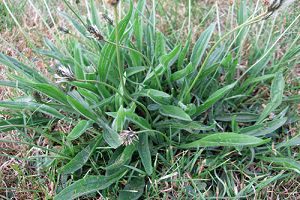
Type: Perennial
Height: 10–40 cm (4 -16 in)
Flowering: April through to October
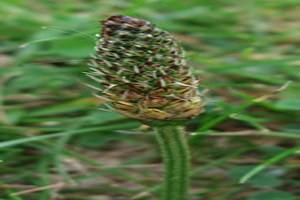
What’s it like?
A very common lawn weed found in all types of lawn conditions. Noticeable because of its long, narrow dark green leaves with distinctive ribs and fine hairs. It grows all year and doesn’t mind being wet or dry. If you remove it, it’s easy to put back down. It has short flowers on a long stem.
Why is it a problem for your lawn?
Plantains often show that your soil is too compacted because they like dry, alkaline soil that is packed down.
Control
If there are only a few weeds in your lawn, you can pull them out by hand. Just make sure you pull out the whole root, or the weed will grow back. A regular mowing will prevent the seed heads forming and reduce spreading. If your soil is packed down, a lawn aeration will help grow a healthy sward and keep ribwort plaintain from taking over your lawn. For a larger infestation, you will need to use a chemical (herbicide) control. This weed should be killed by most selective weed killers, but you will have to treat it again in about six weeks.
CREEPING CINQUEFOIL Potentilla reptans
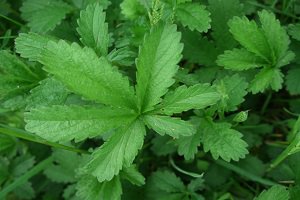
Type: Perennial Broadleaf
Height:10 – 15 cm (4 – 6 in)
Flowering: June through to October
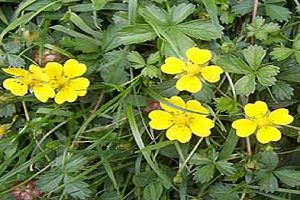
What’s it like?
One of the most common weeds found in lawns. It is often found in poorly maintained lawns that have been neglected. The leaves are easy to identify as they have five different segments and tooth-like edges. It has yellow flowers and fleshy petals. It spreads by creeping stems which root at intervals.
Why is it a problem for your lawn?
Creeping Cinquefoil will spread aggressively by its creeping runners which root at intervals, forming new plants. Your lawn will be uneven in appearance.
Control
You may find hand weed attempts are unsuccessful. A regular raking or light scarifying will help weaken Cinquefoil. For a more serious problem use a selective weed killer. You will need a repeat application approximately 6 weeks later. This weed doesn’t usually grow in well-kept lawns that get regular mowing and care, because that will keep it from spreading. Raking and scarifying will also help weaken this weed considerably, eventually eradicating it.
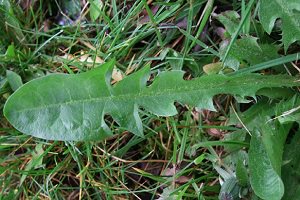
Type: Perennial Broadleaf
Height: 50 cm or more (20 in)
Flowering: March through to November
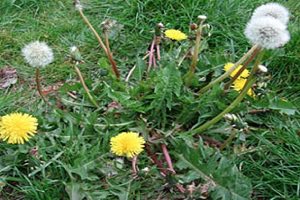
What’s it like?
The Dandelion is a common perennial weed. Although it is a perennial plant it spreads from seed and germinates throughout the year. The seeds are wind-borne and often found germinating along the edges of garden borders. It has a long stout tap root which stretches up to 10 inches. The Dandelion leaves have known health benefits and the flowers are often made into wine. Long and fleshy, the leaves can get quite big, between 3 and 12 inches across. The leaves are simple and basal, forming a rosette above the central taproot. The flower heads are yellow to orange and are open in the daytime but closed at night time.
Why is it a problem for your lawn?
This weed is very persistent. They will spread quickly by seed and will colonise in freshly cultivated soil. They are also able to survive in compacted soil conditions. With their deep roots, they can live and grow back even if the top of the plant is cut off. These weeds will crowd out your grass and create a patchy and problematic lawn. Your lawn will be uneven in appearance.
Control
A thick lawn is the best defense against broadleaf weeds. It can be hard to pull these weeds out by hand because their roots can go very deep into the ground. If you do decide to do this, you should do it before the plants go to seed. There are two types of chemical (herbicide) weed killers that can be used on dandelions. The first is a selective broadleaf herbicide. A broadleaf herbicide will only kill broadleaf weeds, such as dandelions. By using a broadleaf herbicide it will kill the dandelions and not the grass. The other kind to use is a non-selective herbicide. Be careful when you use this kind of product because it will kill any plant it comes in contact with. A non-selective herbicide is effective for spot dandelion removal. It is best to use an herbicide on dandelions before they flower to keep them under control.
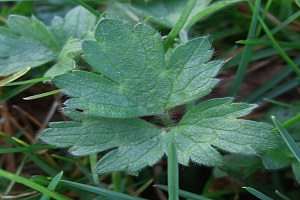
Type: Perennial Broadleaf
Height: Up to 50cm (20 in)
Flowering: May to August
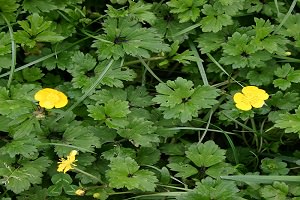
What’s it like?
A very common weed in lawns. Creeping Buttercup is low growing and will be seen in wet heavy soil conditions. This Creeping Buttercup particularly grows with its creeping stem and extends upwards. It has fibrous roots which can be difficult to remove. It has yellow flowers with 6-9 petals each.
Why is it a problem for your lawn?
Creeping buttercup will spread by long runners with deep penetrating roots. They have sub-lateral runners that will develop into a vigorous network of firmly anchored stems in your lawn. They will reproduce from seeds in moist conditions.
Control
The runners of this weed can be dug out in Spring with a trowel. You can use a wire rake to lift the growing runners in the spring before you mow them. This makes it easier for the mower to cut them. By using a Chemical (Herbicide) weed killer you can control this weed. Apply in Spring when the growth is strong and repeat the application if necessary. It is not advisable to use a Non-Selective herbicide as it can come into contact with desirable plants.
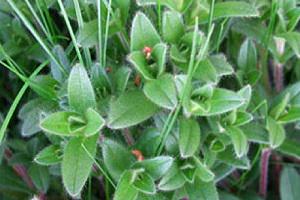
Type: Perennial Broadleaf
Height: 5cm to 20cm, (2 – 8 in) but stems can grow up to 50cm (20 in)
Flowering: Late April to late September
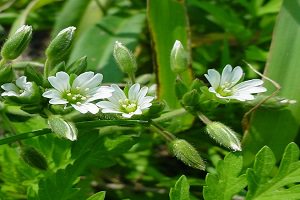
What’s it like?
Birds-foot trefoil is a member of the Clover family. Widely found in lawns and gardens in the UK. Birds-foot trefoil can be found in any kind of soil; however, it particularly likes acidic and drier soils. It will form large patches across your lawn and has a deep root system. Birds-foot trefoil can be grown by under-runners like rhizomes or stolons. It blooms bright yellow flowers that resemble Honeysuckle.
Why is it a problem for your lawn?
This weed can grow in a lot of different types of soil. It will spread out in patches across your lawn, making it uneven. It will seed freely and when scattered large colonies will form quickly. It will survive a close mowing.
Control
For a small infestation, hand weeding may be effective. However, you must be very thorough when attempting to remove the roots below and above the soil level. For a larger infestation, you can use a selective chemical (herbicide) control. In most cases, a further treatment may be necessary to effectively control Birds-Foot Trefoil.
Weed Wars: 7 Powerful Ground Cover Plants to the Rescue! // Gardening Ideas
FAQ
What is a yellow flower creeping weed?
What is an invasive ground cover with yellow flowers?
What is a creeping plant with yellow flowers?
What is the yellow flowering weed invasive?
What is a yellow flowering ground cover?
The yellow-flowering ground cover plant is ideal for growing in rock gardens, ground cover in full sun, border fronts, or containers. They also make excellent hanging basket flowers where the ornamental flowering stems cascade over the side.
Are yellow-flowering weeds a weed?
The label “yellow-flowering weed” is usually subjective. Some stunning ornamental plants like creeping cinquefoil, yellow coneflowers, evening primrose, and golden clover are weedy. Still, they can be useful in a landscape for yellow-flowering ground cover or attracting pollinators. However, other small plants are typically recognized as weeds.
What weeds have yellow flowers?
These include dandelions, purslane, ragwort, and wood sorrel. Flowering weeds with yellow flowers can add a burst of color to any garden or landscape—wanted or unwanted. Many non-native plants are invasive; however, many yellow-flowering weeds benefit the ecosystem.
Are yellow flowering weeds invasive?
Yellow-flowering weeds are among the most common invasive plants growing in yards. The pesky plants with yellow flowers seem to pop up where you least expect or want them. The invasive yellow-flowering wild plants can invade lawns, take over flower beds, choke out cultivated plants, and give you more work weeding the front or backyard.
- The Ultimate Guide to Growing Strawberries in Raised Beds - August 8, 2025
- No-Dig Garden Beds: The Easiest Way to Grow a Beautiful Garden - August 6, 2025
- How to Protect and Preserve Wood for Raised Garden Beds - August 6, 2025

